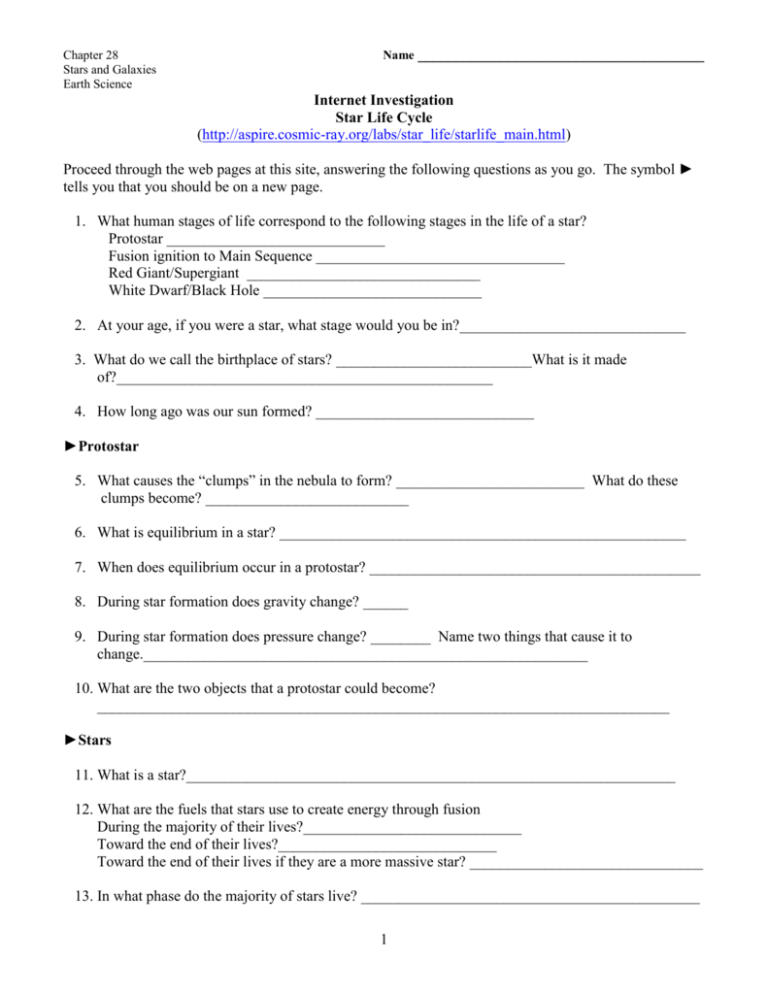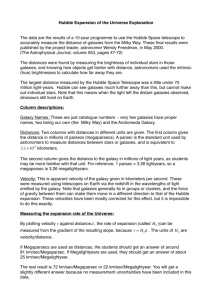Star Life Cycle - Learning on the Loop
advertisement

Chapter 28 Stars and Galaxies Earth Science Name ______________________________________ Internet Investigation Star Life Cycle (http://aspire.cosmic-ray.org/labs/star_life/starlife_main.html) Proceed through the web pages at this site, answering the following questions as you go. The symbol ► tells you that you should be on a new page. 1. What human stages of life correspond to the following stages in the life of a star? Protostar _____________________________ Fusion ignition to Main Sequence _________________________________ Red Giant/Supergiant _______________________________ White Dwarf/Black Hole _____________________________ 2. At your age, if you were a star, what stage would you be in?______________________________ 3. What do we call the birthplace of stars? __________________________What is it made of?__________________________________________________ 4. How long ago was our sun formed? _____________________________ ►Protostar 5. What causes the “clumps” in the nebula to form? _________________________ What do these clumps become? ___________________________ 6. What is equilibrium in a star? ______________________________________________________ 7. When does equilibrium occur in a protostar? ____________________________________________ 8. During star formation does gravity change? ______ 9. During star formation does pressure change? ________ Name two things that cause it to change.___________________________________________________________ 10. What are the two objects that a protostar could become? ____________________________________________________________________________ ►Stars 11. What is a star?_________________________________________________________________ 12. What are the fuels that stars use to create energy through fusion During the majority of their lives?_____________________________ Toward the end of their lives?_____________________________ Toward the end of their lives if they are a more massive star? _______________________________ 13. In what phase do the majority of stars live? _____________________________________________ 1 14. Complete the Interactive Lab which shows what happens to different size stars at the beginning of their life cycles. Small mass Low mass Medium mass Massive *Does this star reach Main Sequence? _________ ________ _________ ________ *How long was it in Main Sequence? _________ ________ _________ ________ 15. Which has a longer life, bigger stars or smaller stars? Explain. ►Stars ►Stars: The beginning of the end. 16. When a star has burned off all of its __________________ and started to burn ______________, this is the beginning of the end. The burning of _________________releases a tremendous amount of energy and the outer shell has expanded in an effort to help heat from the star’s core escape into space. At this point the star is called a ______________________. ►Stars: The end of a star (Use this page and the Interactive Lab at the bottom to answer these questions.) 17. How big is a low mass star? _________________ What stages does it go through? ___________________________________________________ How big is it? ____________________________ What does it become in the end? __________________ 18. How big is a medium mass star? ________________________ What stages does it go through? ___________________________________________________ How big is it? ______________________________________ What does it become in the end? _______________________ 19. How big is a massive star? _____________________________ What happens to a massive star when it burns carbon very rapidly? ________________________________ What stages does a massive star go through? ________________________________________ What does a massive star become in the end (two possibilities)? _____________________________________________________________________________ ►Hertzsprung-Russell Diagram 20. What is a Hertzsprung-Russell Diagram? 21. What does the vertical axis represent? 22. What does the horizontal axis represent? 2 Interactive Lab 23. List the temperature, brightness, and type of star for each of the stars in the lab. a. Betelgeuse – b. Alpha Centauri B – c. Our sun – d. Vega – e. Sirius B – 24. Where do most stars lie on the HR diagram? Galaxies (http://www.windows.ucar.edu/tour/link=/kids_space/milky_way_ask.html) 1. How far across is our galaxy, the Milky Way? 2. How can one locate the center of our galaxy as we orbit the sun and the sun orbits the galaxy? 3. Is our solar system moving away from the center of our galaxy? 4. How many years does it take the sun to orbit the center of the galaxy? 5. The Milky Way is part of a set of about 30 galaxies known as _______________________, which is part of a supercluster known as ___________________________, which is 100,000,000 light years across. 6. What shape is the Milky Way? Classifying Galaxies (http://www.smv.org/hastings/student1.htm) 1. What do you see on the first web page of this site? 2. Where did this image come from? This is a statement about galaxies: "All ellipticals are galaxies, but not all galaxies are elliptical". After you learn how to classify galaxies, you will be able to explain what this statement means. When scientists see objects in nature that share some features, but not others, they find that grouping, or classifying them is a good idea. First they must decide what scheme or plan they will use to decide to which group something belongs. Start with the "Student Lesson" and the blinking message : "Start Galaxy exploration here" What is a galaxy? 1)______________________________________________________________ 3 In the 1920's, an astronomer named Edwin Hubble was able to gather pictures of many galaxies. He noticed that they were not all alike. He decided to group, or classify them. To group the galaxies in the photographs he studied, he could have used size, color, shape or any other feature that he noticed . Hubble decided to classify galaxies by their shape or form. Edwin Hubble looked at many galaxy pictures and decided to divide galaxies into three types according to the way they looked. He used letters to represent these three types of galaxies. 2) The letter "E" meant_________________galaxies, 3)"S" meant _________________galaxies, and 4)"SB" meant ___________________galaxies. Galaxies had so many shapes that Hubble found that three types were not enough. He had to further break down these three according to a slight variation in shape between each type of galaxy in each category. For the "E" or 5)_________________galaxies, he used the amount of flattening or 6)_____________, from E0( E zero) to E5, to put the galaxies into smaller groups. For the "S" or 7)____________ galaxies, he used how tightly the arms were wound around the bright 8)_______________, to further classify these galaxies as Sa, Sb, or Sc. For the "SB" or 9)___________ galaxies, he used the increased openness of the 10)__________to group these galaxies as SBa, SBb, or SBc. Edwin Hubble took all these ideas and presented them all together in a simple diagram for classifying galaxies. This diagram is called the Hubble Tuning Fork Diagram. Most galaxies fall into one of his groups, according to how they look. Draw a shape for each of the types of galaxies below. Draw it above the letters which he used to identify the shapes. (#11-19) E0 E5 Sa Sb Sc SBa SBb SBc S0 20) From the information you have seen today, explain the following statement: "All ellipticals are galaxies, but not all galaxies are elliptical". Put your answer below. Quasars (http://www.windows.ucar.edu/tour/link=/the_universe/QSO.html) 1. Describe quasars. 2. Quasars are most likely ___________________________, formed around ____________________________________. 3. Quasars are so bright because the matter is unimaginably ______________. 4








